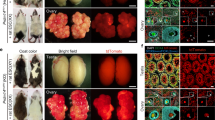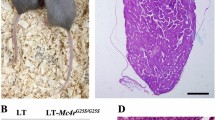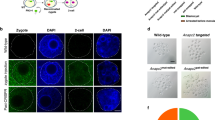Abstract
Current techniques for making transgenic mice are cumbersome, requiring trained personnel, costly infrastructure and collection of many zygotes from mice that are then killed. We developed a reproducible nonterminal technique for transfecting genes in undifferentiated spermatogonia through in vivo electroporation of the testis; about 94% of male mice electroporated with different transgenes successfully sired transgenic pups. Such electroporated males provide a valuable resource for continuous production of transgenic founders for more than a year.
This is a preview of subscription content, access via your institution
Access options
Subscribe to this journal
Receive 12 print issues and online access
$259.00 per year
only $21.58 per issue
Buy this article
- Purchase on Springer Link
- Instant access to full article PDF
Prices may be subject to local taxes which are calculated during checkout



Similar content being viewed by others
References
Cameron, E.R. Mol. Biotechnol. 7, 253–265 (1997).
Wolf, E. et al. Exp. Physiol. 85, 615–625 (2000).
Brinster, R.L. Science 296, 2174–2176 (2002).
Nagano, M. et al. Proc. Natl. Acad. Sci. USA 98, 13090–13095 (2001).
Kanatsu-Shinohara, M., Toyokuni, S. & Shinohara, T. Biol. Reprod. 72, 236–240 (2005).
Chang, K. et al. J. Reprod. Dev. 45, 29–36 (1999).
Yamazaki, Y. et al. J. Exp. Zool. 286, 212–218 (2000).
Kanatsu Shinohara, M., Toyokuni, S. & Shinohara, T. Biol. Reprod. 71, 1202–1207 (2004).
Scobey, M. et al. Endocrinology 142, 948–954 (2001).
Huang, Z. et al. FEBS Lett. 487, 248–251 (2000).
Kanatsu-Shinohara, M. et al. Proc. Natl. Acad. Sci. USA 99, 1383–1388 (2002).
Umemoto, Y. et al. J. Androl. 26, 264–271 (2005).
Han, S. et al. Biol. Reprod. 71, 933–941 (2004).
Bienvenu, G. et al. Endocrinology 145, 2412–2420 (2004).
Yeh, J.R., Zhang, X. & Nagano, M.C. Biol. Reprod. 77, 897–904 (2007).
Acknowledgements
We thank S. Babajko (Institut National de la Santé et de la Recherche Médicale, Paris), S. Chattopadhyay (National Center for Cell Science, Pune, India), Y. Junming (University of Tennessee, Memphis) and J. DeJong (University of Texas at Dallas) for providing constructs. We are thankful for technical inputs of A. Usmani and M. Gautam at various steps. We thank S.K. Basu, A. Surolia, K.V.S. Rao and T.M. Plant for their helpful suggestions. We acknowledge the help of V. Bal, A. Mukhopadhyay, K. Sarda, M. Shrivastava, P. Seth, A. Basu and R. Das for immunohistochemistry and stem cell culture–related work. This work was funded by the National Institute of Immunology (India) and Department of Biotechnology. We are also thankful to Indo-US Contraceptive and Reproductive Health Research program.
Author information
Authors and Affiliations
Corresponding author
Supplementary information
Supplementary Text and Figures
Supplementary Figures 1–10, Supplementary Tables 1–2, Supplementary Methods, Supplementary Protocol, Supplementary Note (PDF 1111 kb)
Rights and permissions
About this article
Cite this article
Dhup, S., Majumdar, S. Transgenesis via permanent integration of genes in repopulating spermatogonial cells in vivo. Nat Methods 5, 601–603 (2008). https://doi.org/10.1038/nmeth.1225
Received:
Accepted:
Published:
Issue Date:
DOI: https://doi.org/10.1038/nmeth.1225
This article is cited by
-
Intratesticular injection followed by electroporation allows gene transfer in caprine spermatogenic cells
Scientific Reports (2018)
-
Nucleic acids delivery methods for genome editing in zygotes and embryos: the old, the new, and the old-new
Biology Direct (2016)
-
Robust generation of transgenic mice by simple hypotonic solution mediated delivery of transgene in testicular germ cells
Molecular Therapy - Methods & Clinical Development (2016)
-
An Efficient Method for Generation of Transgenic Rats Avoiding Embryo Manipulation
Molecular Therapy - Nucleic Acids (2016)
-
An efficient strategy for generation of transgenic mice by lentiviral transduction of male germline stem cells in vivo
Journal of Animal Science and Biotechnology (2015)



